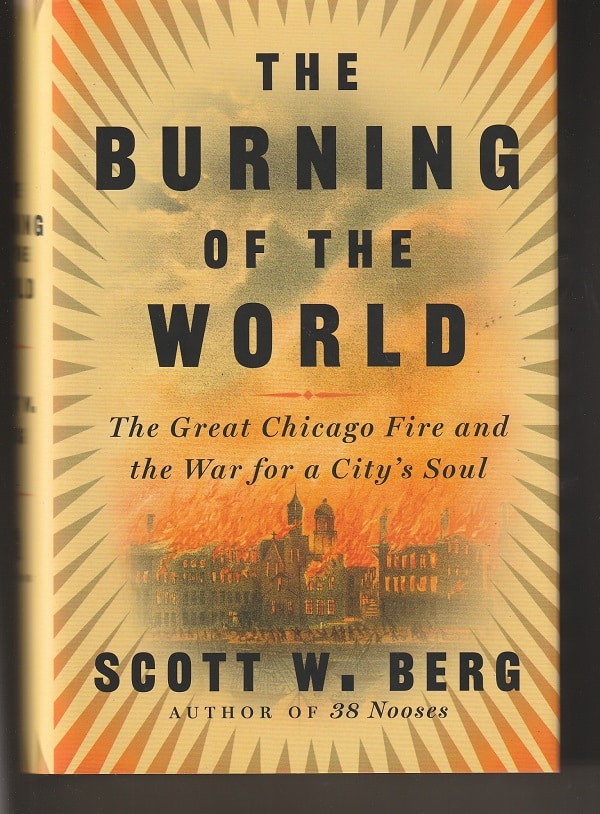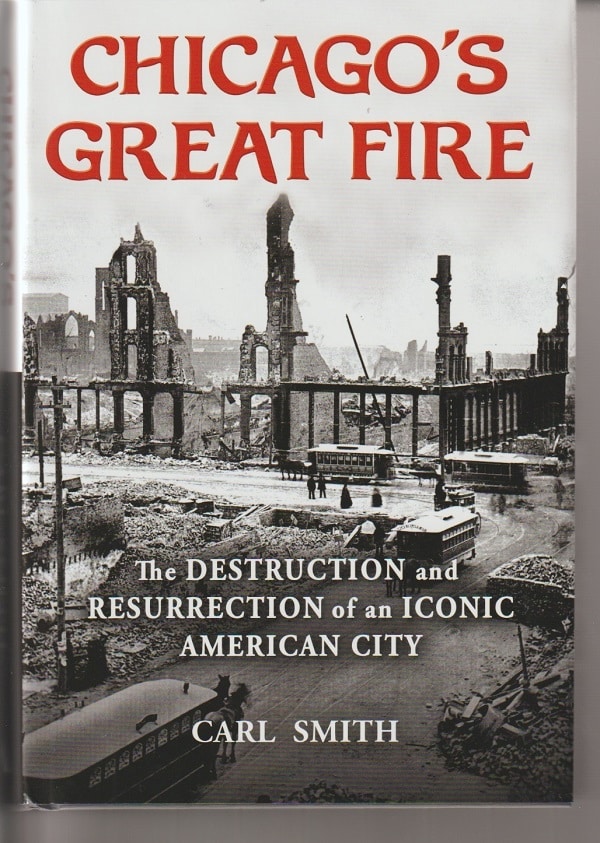As someone who writes books, I felt a pang of empathy for Scott W. Berg when I heard that he’d published in September a new book about the Great Chicago Fire.
Here’s what I imagined: I pictured Berg, a Twin Cities author, going through the long and arduous process to research and write his book and get it ready to be published around the 150th anniversary of the huge 1871 blaze that destroyed much of Chicago.
I imagined him doing all this — and, then, before he could get into print, another big book about the fire hit the bookstores in August, 2020: Chicago’s Great Fire: The Destruction and Resurrection of an Iconic American City by Carl Smith, a retired Northwestern University history professor and noted expert on the blaze.
In a Third Coast review, I wrote that Chicago’s Great Fire was “an important book of Chicago, highly readable and deeply researched…[and] also the first book since the 1871 conflagration to tell the story of the fire in a comprehensive way.”
So, three years later, when I heard of Berg’s book, I felt that authorial pang because The Burning of the World: The Great Chicago Fire and the War for a City’s Soul is an attempt to do the same thing, to give a full picture of the blaze and its many after-effects.
The better book
I have no factual basis for my imagined scenario above, but there is no doubt that things are much more complicated for The Burning of the World because it’s arrived three years after Smith’s book.

Does the reading world need two extensive and in-depth efforts to weave together a great deal of old documentation and new research about how Chicago was shaped by the fire that caused so much damage and loss?
But that question’s moot since the two books are here. So, a more apt question is whether one is better than the other or whether the two are enough different and valuable to warrant space next to each other on a reader’s bookshelf.
My short answer: Smith’s is the better book, but there is a lot of good stuff in The Burning of the World. Let me quickly add that another reader might make a different judgement because Berg’s could be perceived as a more “popular” approach to the telling of the story.

Berg and Smith
Smith’s book is better, I think, because the central character in the story is the city — that entity of people and place that was Chicago in 1871 and later. It’s artfully written and extensively documented, featuring 45 pages of endnotes.
In The Burning of the World, Berg tells his story by focusing on particular people, such as Matthias Schaefer, the fireman on the roof of the courthouse spotting fires on the night of October 8; Joseph Medill, the Chicago Tribune publisher who became the city’s mayor in the months after the blaze; and Charles C. P. Holden, the president of the Common Council, the equivalent of today’s City Council.
For instance, here is how he introduces Holden:
As the Monday morning sun rose behind thin clouds and smoke on a city decimated in one part and still burning fiercely in another, a stout, extravagantly square-jawed forty-four-year-old man named Charles Courtney Pickney Holden summoned his driver and climbed into his carriage outside his West Side house…Far enough from the conflagration to avoid any thought of flight, Holden aimed to turn the tables and follow in the fire’s path instead.
That excerpt is a good example of Berg’s writing style. He aims to bring his story alive with sharp, vivid language and interesting personalities. In that way, it is reminiscent of Chicago, City of the CenturyCity of the Century: The Epic of Chicago and the Making of America, Donald L. Miller’s 1996 history of the city prior to the twentieth century.
“Chunks of fire”
Smith is no slouch when it comes to lively language, but he leans more on the words of the eyewitnesses and stitches together those accounts to create his narrative. By contrast, Berg aims to narrate the story in his own words, adding here and there the words of those who went through the fire.
Here, for example, is Smith:
The flames gorged themselves on the Bateham buildings and all the wood near them. The firemen were no longer battling a mere fire, but an inferno….
The fire [said Fire Chief Robert A. Williams] “was coming down thicker than any snowstorm you ever saw, and the yard between the two mills was all filled with shavings, and chunks of fire came in all sizes, from the length of your arm to three inches.”
And here is Berg, describing what Holden saw in his carriage ride behind the fire:
To his right he saw untouched homes on small, tidy lots, local businesses still open, gawkers gathered on every corner, residents of the west side of the street counting their blessings.
To his left, as far as he could see, everything was a dark junkyard of desolation. As his driver led him down Jefferson and across Harrison, Holden saw in the southwest corner of the intersection eight forms shrouded in white: eight dead bodies arranged side by side, like a row of piano keys….[T]hose dead Chicagoans were his first glimpse of the fire’s true violence, and he would never forget the sight.
Vantage Points
In this excerpt, Berg puts the reader in the moment by emphasizing what could be seen from Holden’s vantage point. This is a strategy he uses in many places during his 80-page narrative of the fire.
For instance, building on Medill’s own report, Berg envisions what the publisher could see from the roof of the Tribune building in various directions. When I say “envision,” I mean that Berg takes Medill’s report as well as a lot of other documentation about the fire and then imagines what a person could see from that roof. He does this throughout his book, especially when writing about the fire.
In that roof scene, Berg also envisions what could be seen below — streets full of people and animals:
Great mischiefs of brown rats swarmed out from unseen crevices, while flight of pigeons madly sought escape from the rising smoke. Pigs, goats, cows, horses, dogs, cats, and chickens scurried about…
This is a startling description although it’s not from Medill’s account of that night. It seems based on the account of a Chicago Evening Post reporter who wrote:
Cats ran along ridge-poles in the bright glare, and came pattering into the street with dropsical tails. Great brown rats with beadlike eyes were ferreted out from under the sidewalks by the flames, and scurried along the streets, kicked at, trampled upon, hunted won. Flocks of beautiful pigeons…wheeled aimlessly, circled blindly once or twice, and were drawn into the maw of the fiery hell raging underneath.
This report is quoted in Smith’s book and referenced in an endnote indicating the source. Berg makes no mention of it in his 12 pages of endnotes because he aims to make his account of the fire into a story with himself as the storyteller. As a reader, I prefer Smith’s approach with his clear source notes. Most of the time, Berg gives no indication what he was using to envision — imagine — a scene.
Berg’s approach, however, will be more attractive to some readers inasmuch as it’s a story about history — it’s breezier, it flows more smoothly, it tips off the reader which characters are admirable and which less so.
It’s an approach that I found less successful when dealing with the events and actions in Chicago in the months and years after the fire — a period which takes up a good two-thirds of both Berg’s and Smith’s books. Because he centers his writing on personalities, Berg tells a story in this latter section that’s somewhat disjointed. Smith’s account is more focused because his main character is the city.
The O’Learys — or Learys?
There’s one last odd thing to note, and it has to do with Catherine O’Leary, the much-maligned, falsely accused Mrs. O’Leary of fire lore.
Throughout his book, Berg refers to her and her family members by the last name of Leary, stating, in passing, that, after the fire, an O’ was added to the name by newspapers and government officials. This runs counter to the name that has been used for and by the family for more than a century and a half, so it’s a significant choice on Berg’s part. But he never explains, as far as I could tell, why he made this decision.
Smith, for his part, has a long endnote about the O’Leary family and how various records got their ages wrong. He also adds, “The O’ was often dropped on names like theirs, so in some records they are listed as Leary,” and he cites an 1894 Chicago Tribune article as an example.
That’s an illustration of why Smith’s approach and his book are more attractive to me than Berg’s.
Patrick T. Reardon
12.14.23
This review originally appeared at Third Coast Review on 12.8.23.
Written by : Patrick T. Reardon
For more than three decades Patrick T. Reardon was an urban affairs writer, a feature writer, a columnist, and an editor for the Chicago Tribune. In 2000 he was one of a team of 50 staff members who won a Pulitzer Prize for explanatory reporting. Now a freelance writer and poet, he has contributed chapters to several books and is the author of Faith Stripped to Its Essence. His website is https://patricktreardon.com/.
